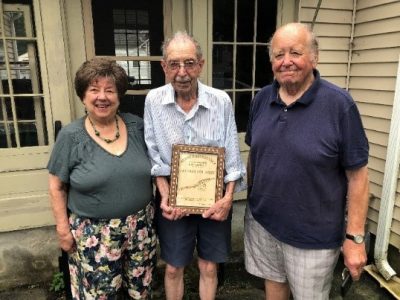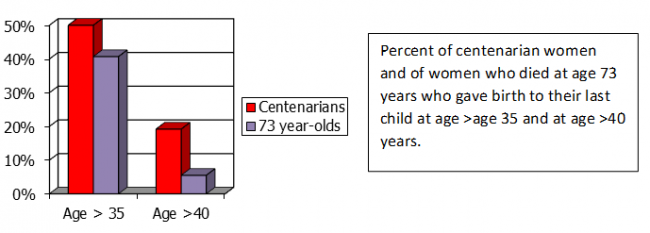
Welcome to the largest and most comprehensive study of centenarians and their families in the world!
To Discover the Secrets of a Long and Healthy Life
Para Español, presiona AQUÍ
Check out our most recent webinar!
WEBINAR – New England Centenarian Study – February 29, 2024



The New England Centenarian Study (NECS) has been enrolling and studying centenarians and their family members since 1995. The NECS has been based at Boston University’s Chobanian and Avedisian School of Medicine since 2002 and it is codirected by Robert D. Evans Distinguished Professor Tom Perls MD, MPH and Stacy Andersen, PhD.
Paola Sebastiani, PhD and her biostatistics group based at the Center for Quantitative Methods and Data Science (Tufts Medical Center) leads our data analyses efforts and Professor Sebastiani is the co-lead principal investigator the Integrative Longevity Omics Study and the Centenarian Project of the Longevity Consortium.
| If you are a centenarian or know of a centenarian who might be interested in furthering our understanding of what it takes to live 100+ years, we would love to hear from you!
Please contact us toll-free at 1-888-333-6327 or by email at agewell@bu.edu. You can also reach the Principal Investigator, Tom Perls MD, MPH at thperls@bu.edu. By determining how centenarians and their relatives age so slowly and markedly delay or even escape aging-related diseases, we hope to contribute to the development of strategies and even drugs that do the same in average aging people. It is very important that we have an ethnically and racially diverse sample of participants in our studies so that we are sure that our findings apply to everyone and not any one group. Understanding differences and similarities in how people with different genetic backgrounds and environmental exposures achieve very old age and age well is critically important to the success of this research. |
Some of Our Key Findings:
- Exceptional longevity runs strongly in families.
- Among centenarians, disability is compressed towards at least their early- to mid-nineties.
- At older ages of survival, e.g., age 105+ years, morbidity (age-related diseases) is also compressed towards the end of these exceptionally long lives.
- The genetic influence upon survival increases with older and older ages of survival beyond the nonagenarian years.
- This genetic influence probably involves many genetic variants with individually modest effects, but as a group, they have a strong effect.
- But for some rare exceptions, centenarians have just as many disease-associated genetic variants as the average population. Thus, their genetic advantage is likely due to variants that slow aging and decrease risk for aging-related diseases such as heart disease, stroke, cancer, diabetes and Alzheimer’s Disease.
View our March 2022 Webinar here: Centenarians and Their Families
Our Currently Funded Studies
The New England Centenarian Study oversees four studies of exceptional longevity that are funded by the National Institute on Aging (NIA), an institute of the National Institutes of Health (NIH).
Visit the Studies page to learn more about each study.
Discoveries & Publications (of >180 peer reviewed papers)
Visit the Publications page for more from our investigators.
Genetic Signatures of Exceptional Longevity in Humans
Genes play a critical and complex role in facilitating exceptional longevity. The genetic influence becomes greater and greater with older and older ages, especially beyond 100 years of age.
- Because many genes are involved, one needs to include many different genes at once (rather than one at a time) in what is called a genetic profile to accurately categorize who is a centenarian and who is not, based on genetic data alone.
- We found 281 genetic markers that are 61% accurate in predicting who is 100 years old, 73% accurate in predicting who is 102 years old or older and 85% accurate in predicting who is 105 years old or older. In other words, the prediction gets better with older and older ages beyond 100 which goes along with our hypothesis that the genetic component of exceptional longevity gets greater and greater with older and older age.
- These 281 markers point to at least 130 genes, many of which have been shown to play roles in Alzheimer’s, diabetes, heart disease, cancers, high blood pressure, and basic biological mechanisms of aging.
- Centenarians have just as many genetic variants (but for a few rare exceptions) associated with increased risk for age-related diseases (like Alzheimer’s, heart disease, stroke, diabetes and cancer) as people in the general population. Therefore, their tremendous survival advantage may in great part be due to the existence of longevity associated genetic variants that are protective and counter the negative effects of such disease gene variants.
- Participants in our study have genetic profiles that can be constructed from these 281 genetic markers (each of which has 3 variations) and these in turn are associated with specific probabilities of achieving very old age. Very interestingly, sub-groups of subjects have genetic profiles in common (what we call genetic signatures). Ninety percent of the 801 centenarians in the New England Centenarian Study can be characterized by one of 27 genetic signatures.
- These genetic signatures are also associated with different predispositions to subgroups of centenarians such as those that completely escape heart disease, or those that delay Alzheimer’s disease until the last 5% of their very long lives. This method of generating signatures will be very useful for better understanding the underlying genetics of protection from age-related diseases, modulators of rates of aging and for the field of predictive and precision medicine.
Citation:
Genetic Signatures of Exceptional Longevity in Humans. Paola Sebastiani, Nadia Solovieff, Andrew T. DeWan, Kyle M. Walsh, Annibale Puca, Stephen W. Hartley, Efthymia Melista, Stacy Andersen, Daniel A. Dworkis, Jemma B. Wilk, Richard H. Myers, Martin H. Steinberg, Monty Montano, Clinton T. Baldwin, Josephine Hoh, Thomas T. Perls. PloS ONE 2012. DOI: 10.1371/journal.pone.0029848.
Related Citations:
Meta-analysis of genetic variants associated with human exceptional longevity. Paola Sebastiani, Harold Bae1, Fangui X. Sun, Stacy L. Andersen, E. Warwick Daw, Alberto Malovini, Toshio Kojima, Nobuyoshi Hirose, Nicole Schupf, Annibale Puca, Thomas T Perls. Aging (Albany NY) 2013 September; 5(9): 653–661. Published online 2013 August 24. PMCID: PMC3808698
Increasing sibling relative risk of survival to older and older ages and the importance of precise definitions of “aging”, “life span” and “longevity”. Sebastiani P, Sun F, Andersen S, Black M, Perls T. J Gerontology Biol Sci. 2015;71:340-346.
Stevenson M, Bae H, Schupf N, Andersen S, Zhang Q, Perls T, Sebastiani P. Burden of disease variants in participants of the long life family study. Aging (Albany NY). 2015 Feb 5. http://www.impactaging.com/papers/v7/n2/pdf/100724.pdf
Limitations and risks of meta-analyses of longevity studies. Sebastiani P, Bae H, Gurinovich A, Soerensen M, Puca A, Perls TT. Mech Ageing Develop. 2017 http://www.sciencedirect.com/science/article/pii/S0047637416301774
Four Genome-Wide Association Studies Identify New Extreme Longevity Variants. Sebastiani P, Gurinovich A, Bae H, Andersen S, Malovini A, Atzmon G, Villa F, Kraja AT, Ben-Avraham D, Barzilai N, Puca A, Perls TT. J Gerontol A Biol Sci Med Sci. 2017 Mar 15. doi: 10.1093/gerona/glx027.
The Older You Get, The Healthier You’ve Been
Early on in The New England Centenarian Study, we thought that centenarians had to markedly delay or even escape age-related diseases like heart attacks, stroke, diabetes and Alzheimer’s, or else they would never be able to get to their very old ages. In fact, in 1980, a Stanford researcher named James Fries proposed the “Compression of Morbidity” hypothesis which states that as one approaches the limit of human life span, they must compress the time that they develop diseases towards the very end of their life and he proposed that people around the age of 100 do this.
However, in 2003 we found that many of our centenarian subjects had age related diseases even before the age of 80 (about 43%, and whom we called “survivors”), after the age of 80 (about 42% and whom we called “delayers”) and lastly, those who had no mortality-associated diseases at age 100 (about 15% and whom we called “escapers”). The key though was that 90% of all of the centenarians were still independently functioning at the average age of 93 years. Somehow, despite the presence of diseases, people who become centenarians don’t die from those diseases, but rather they are able to deal with them much better than other people and remain independently functioning more than 30 years beyond the age of 60.
Therefore it seemed to us that for these study participants, it was not so much the compression of morbidity that was important to their survival, but rather a compression of disability.
Citation:
Evert J, Lawler E, Bogan H, Perls T. Morbidity profiles of centenarians: survivors, delayers, and escapers. J Gerontol A Biol Sci Med Sci. 2003 Mar;58(3):232-7. doi: 10.1093/gerona/58.3.m232. PMID: 12634289.
Compression of Morbidity Generally Does Not Apply at Age 100, But Rather at Much Rarer Ages, approximately 106+ years
We found that when we were investigating Jim Fries’ compression of morbidity hypothesis, studying people around age 100 was not old enough. After all, the limit of human life span is not 100 years, but instead 122 years.
Once we enrolled our hundredth super-centenarian (those age 110+ years old), by far the largest collection of supers in the world, we were able to investigate whether or not people who truly approach the limit of human lifespan actually compress their morbidity towards the end of their lives.
In our study of a reference group, nonagenarians (subjects in their nineties), centenarians (ages 100-104), semi-supercentenarians (ages 105-109) and supercentenarians(ages 110+), the subjects had progressively shorter periods of their lives spent with age-related diseases, from 17.9% of their lives in the referent group, to 9.4% in the nonagenarians and down to 5.2% in the supercentenarians. These findings support the compression of morbidity hypothesis and the idea that there truly is a limit to human life span. We also noted that the supercentenarians were much more alike in terms of the markedly delayed age of onset of age-related diseases compared to the study participants age 100-104 who were quite heterogeneous.
The phenotypic or clinical homogeneity among the supers indicates they must have some factors (presumably genetic) in common that allow them to be so similar. We believe that our oldest subjects give us the best chance and discovering these genes.
Citations: Health span approximates life span among many supercentenarians: Compression of morbidity at the approximate limit of life span Andersen SL, Sebastiani P, Dworkis DA, Feldman L, Perls T. J Gerontol A Biol Sci Med Sci 2012;67A:395-405.
Families Enriched for Exceptional Longevity also have Increased Health-Span: Findings from the Long Life Family Study. Paola Sebastiani, Fangui X. Sun, Stacy L. Andersen, Joseph H. Lee, Mary K. Wojczynski, Jason L. Sanders, Anatoli Yashin, Anne B. Newman, Thomas T. Perls. Front Public Health. 2013; 1: 38. PMCID: PMC3859985.
Whole Genome Sequences of 2 Supercentenarians
The New England Centenarian Study, along with collaborators at the Scripps Institute and the University of Florida, Gainesville, performed and published the first-ever whole genome sequence of a supercentenarian –and actually not one super, but two, both over the age of 114 years and one was a man and the other a woman. As with our paper on the genetic signatures of exceptional longevity, we found here as well that centenarians have just as many genetic variants associated with diseases as the general population. However, they likely also have longevity-associated variants that counteract such disease genes, thus allowing for slower aging and increased resistance to age-related diseases.
In this paper we also found several genes that occurred in our published genetic prediction model which had coding regions that led to differences in gene function. These findings support the validity of the genetic prediction model. The New England Centenarian Study has posted the whole genome sequences of these two subjects on a data repository (called dbGaP) based at the National Institutes of Health.
Citation: Whole genome sequences of male and female supercentenairnas, Both ages >114 years. Sebastiani P, Riva A, Montano M, Pham P, Torkamani A, Scherba E, Benson G, Milton JN, Baldwin CT, Andersen S, Schork NJ, Steinberg MH, Perls T. Frontiers in Genetics of Aging 2012;2.
Middle Age Mothers Live Longer and the evolutionary pressure for genes that slow aging and decrease risk for aging related diseases that adversely impact reproduction
There is a growing body of evidence for a substantial genetic influence upon survival to the most extreme ages. An important question is what would be the selection pressure(s) for the evolution of longevity associated genetic variants. The pressure to have a longer period of time during which women can bear children and therefore have more of them and therefore have greater success in passing one’s genes down to subsequent generations could be one such pressure. This hypothesis is consistent with the disposable soma theory where the trade-off in energy allocation between reproductive fitness and repair/maintenance functions can be delayed when longevity associated variants facilitate slower aging and the delay or prevention of age-related diseases that also adversely affect fertility.
Several studies have noted an association between older maternal age and an increased odds of exceptional survival. The New England Centenarian Study assessed maternal age history in its sample of female centenarians and a birth-cohort-matched referent sample of women who survived to the cohort’s average life expectancy. Women who gave birth to a child after the age of 40 (fertility assistance was not technologically available to this cohort) had a four times greater odds of being a centenarian.
Numerous investigators are now searching for and investigating genes that influence reproductive fitness in terms of their ability to also influence rate of aging and susceptibility to age-related diseases.

Citations: Middle-aged mothers live longer. Perls TT, Alpert L, Fretts RC. Nature. 1997 Sep 11;389(6647):133.PMID: 9296486
Extended maternal age at birth of last child and women’s longevity in the Long Life Family Study. Sun F, Sebastiani P, Schupf N, Bae H, Andersen SL, McIntosh A, Abel H, Elo IT, Perls TT. Menopause. 2015 Jan;22(1):26-31.
Our Data Sharing Policy
The data that we generate are unique and very difficult to come by both because of the rarity of centenarians and also the expense involved in generating the huge amount of clinical and biological data described above. In accordance with NIH/NIA policy all the data that we generate (without sharing participant or family identities) will be posted on the following NIA supported web-portals for sharing with researchers from around the world. Doing so maximizes the research field’s opportunity to make impactful discoveries.


The New England Centenarian Study Investigators are most thankful to the following funders and donors for their financial support and guidance:
- The Paulette and Marty Samowitz Foundation
- The William M. Wood Foundation
- The American Federation of Aging Research
- The Chobanian and Avedisian School of Medicine’s Department of Medicine and Geriatrics Section and the Robert Dawson Evans Distinguished Professorship
- The National Institute on Aging, National Institutes of Health



